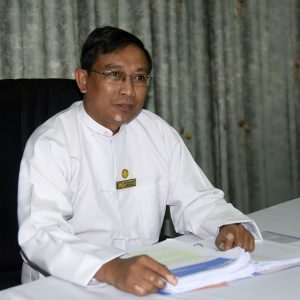In response to the emergence of the novel coronavirus (2019-nCoV) in Wuhan City of China, Myanmar officials and especially the Ministry of Health and Sports are vigilant to prevent and contain any case of the novel coronavirus at states and regions, health departments, airports, harbours and border gates, with extra attention given to checkpoints that border with China.
The following are excerpts from interviews with health officials Dr Tun Tin and Dr Than Naing Soe where they explain the processes of the health ministry in responding to the Wuhan coronavirus.

Dr Tun Tin (Director)
(Central) Contagious Disease Prevention and Eradication Sub-Department
Q: What can you tell us about the cases of pneumonia occurring in China that has been circulating in the media recently?
A: The virus has been spreading in Wuhan City between December 2019 and January 2020. Initial reports from the Wuhan Municipal Health Commission said they could not identify this strain of virus but they did say it was connected to a seafood market in Wuhan. It was closed down on 1 January and the surrounding area was cleaned. The World Health Organization then announced on 7 January that the virus is a new strain of the coronavirus family.
Q: Can you explain about the measures taken to prevent and control the spread of the virus in Myanmar.
A: The Public Health Department have always implemented monitoring activities at international airports, docks and border gates to prevent the entry of SARS, MERS, Zika and the Ebola virus, and we will continue to do so. In fact, we had increased efforts in existing prevention and quarantine processes before WHO made their announcement on 5 January, 2020.
International media reported on 3 January that a pneumonia-causing virus had been spreading in China and authorities could yet to identify it. We responded to it as quick as we could and a team led by the deputy director-general of disease eradication and the Mandalay Region public health head official went to monitor the situation at Mandalay Airport.
We increased monitoring for flu and fever symptoms, planned to operate separate patient rooms and worked together with airport authorities and airlines to sent suspected passengers to the nearest hospital on time.
There are direct flights from Wuhan to Mandalay Airport twice a week and, as a result, we installed an additional fever scanner at the airport on 7 January to aid our monitoring efforts.
When WHO announced on 7 January that the pathogen responsible for the sickness in China was the Novel Coronavirus, the Ministry of Health and Sports uploaded health announcements regarding winter pneumonia awareness on their website at https://www.mohs.gov.mm, their Facebook page, Myanmar CDC Facebook page (https://web.facebook.com/MyanmarCDC/) and the Facebook page of the Health Information Promotion Sub-department on 8 January. We also held a coordination meeting to effectively address the situation.
On 9 January, a team led by the director of communicable diseases traveled to Mandalay Airport and enhanced monitoring processes, meeting with airline officials, and discussing with Mandalay Region Health Department to appoint full-time health officers at the airport.
Similarly, a team led by the deputy-director general of disease eradication traveled to Yangon International Airport and its docks on 11 January, while the director of communicable diseases led a team to Nay Pyi Taw International Airport on 14 January to boost the disease monitoring processes there. The same team visited the 1000-bed general hospital in Nay Pyi Taw the next day and discussed setting up separate patient rooms with the medical superintendent.
We have uploaded prevention techniques and true news sources for the public on the ministry’s website (www.mohs.gov.mm) and Facebook page, and Myanmar CDC’s Facebook page from 18 to 22 January as well.
Q: What are other countries doing to protect themselves from the pneumonia virus in China?
A: Countries that neighbour China, such as Hong Kong, Malaysia, Philippines, Singapore, Taiwan, Thailand, Russia and Viet Nam monitor passengers entering their airports and docks for virus symptoms, especially direct flights from Wuhan. The US and EU are also performing necessary health checks on passengers coming on direct flights from Wuhan Airport.

Dr Khin Khin Gyi (Deputy Director)
(Central) Contagious Disease Prevention and Eradication Sub-Department
Q: WHO said the coronavirus is the cause of the pneumonia cases happening recently. Can you tell us a bit more about that?
A: Coronavirus is the name for a family of viruses that cause illnesses ranging from the common cold to more severe respiratory diseases such as pneumonia, SARS, MERS, kidney failure and even death.
Coronaviruses are common in many different species of animals and rarely transmit to or between humans. However, some strains can infect humans and the people who have it pass on the quickest to their family or caretakers who live in close proximity to them.
Coronaviruses that never used to infect people but have evolved to do so are called novel coronavirus. MERS and SARS are examples of novel coronaviruses that have transmitted from animals to humans. They cause severe respiratory symptoms and deaths upon people.
Symptoms of the 2019 novel coronavirus include high fever, headaches, coughing, chest pain and difficulty breathing. Severe viruses can cause respiratory and kidney failure, hardening of the lungs, damages to the respiratory system and intestines, sepsis and death.
Q: Does the coronavirus transmit from people to people?
A: While some coronaviruses can be transmitted from person to person, there is still concrete evidence that the 2019 novel coronavirus (2019-nCoV) has spread through this method. SARS and MERS were caused by respiratory infections, the new virus is still being studied to figure out if it follows the same method.
WHO announced on 15 January that the novel coronavirus has limited human to human transmission as it is most frequently transmitted from the person who has it to some of the medical staff looking after them.
Q: Is there any relation between the SARS and MERS viruses and the recent coronavirus?
A: According to lab tests, the SARS virus that hit China in 2002 was transmitted to humans through the civet cat while the MERS virus that spread throughout Saudi Arabia in 2012 was transmitted from camels. As global disease monitoring becomes more advanced, we are able to see more transmissions of coronaviruses.
Recent lab tests show that while the 2019 novel coronavirus is different from MERS and SARS, it is similar in having a high transmission rate from animals to humans. It is still being monitored and diagnosed.
Q: Can the novel coronavirus be protected through vaccines?
A: There are still no vaccines for the novel coronavirus yet, nor a precise cure. But effective treatment can be administered depending on the person’s health condition.
Q: What’s the global statistic regarding this new virus?
A: According to WHO’s announcement on 23 January, there are 581 cases of the virus, with 574 people in China having the virus, 4 in Thailand, and 1 each in Japan, South Korea and the US.
Q: And how many cases have been fatal?
A: Chinese authorities have announced that lab results show 17 people have died from the virus in Wuhan, as of 23 January. The majority of deaths are elderly people and those with chronic illnesses. That’s why they need to give extra attention to medical guidelines.
Q: Have any cases of the virus popped up in Myanmar?
A: There have been no cases of the virus when we last checked on 24 January. We are using thermal scanners to monitor all passengers at airports and border gates also have thermal scanners and non-contact thermometers to look out for signs and symptoms of the virus.
Q: What is WHO doing to address this virus?
A: WHO held a meeting of the Emergency Committee convened by their Director-General under the International Health Regulations (IHR) (2005) from 22 to 23 January, 2020. They decided it was still too early to declare the situation a Public Health Emergency of International Concern (PHEIC) and decided to continue further investigations and containment procedures.
WHO’s standard recommendations for the general public to reduce exposure to and transmission of a range of illnesses are as follows, which include hand and respiratory hygiene, and safe food practices:
• Frequently clean hands by using alcohol-based hand rub or soap and water;
• When coughing and sneezing cover mouth and nose with flexed elbow or tissue – throw tissue away immediately and wash hands;
• Avoid close contact with anyone who has fever and cough;
• If you have fever, cough and difficulty breathing seek medical care early and share previous travel history with your health care provider;
• When visiting live markets in areas currently experiencing cases of novel coronavirus, avoid direct unprotected contact with live animals and surfaces in contact with animals;
• The consumption of raw or undercooked animal products should be avoided. Raw meat, milk or animal organs should be handled with care, to avoid cross-contamination with uncooked foods, as per good food safety practices.
(This interview was conducted on 24 January 2020)
Interview By: Shin Min, Photo: Htein Nan Naw
(Translated by Pen Dali)



